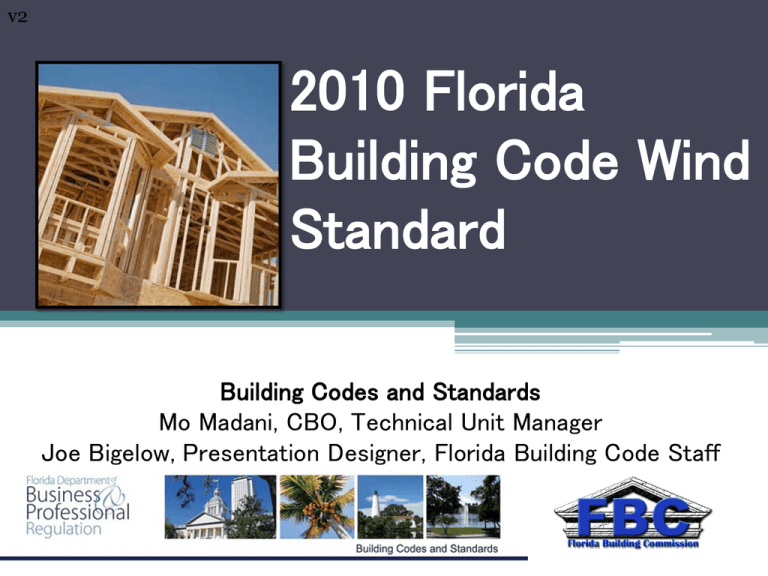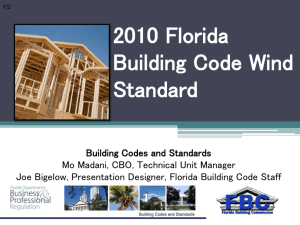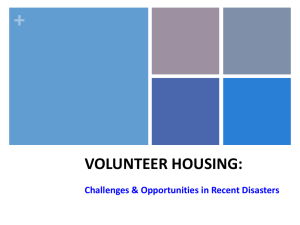2010 Code Changes - Florida Building Code
advertisement

v2 2010 Florida Building Code Wind Standard Building Codes and Standards Mo Madani, CBO, Technical Unit Manager Joe Bigelow, Presentation Designer, Florida Building Code Staff 2 • Contents ▫ Part 1 - The Florida Building Code ▫ Part 2 – Wind Speeds ▫ Part 3 – Impact 2 3 Part 1 The 3 Florida Building Code 4 5 • How to use the next chart The 2004 Florida Building Code Mechanical Volume is based on the 2003 IMC (International Mechanical Code) 5 Florida Building Code Editions Effective Date Building Volume – Based on… Plumbing Volume – 2001 FBC 2004 FBC 2007 FBC 2010 FBC March 1, 2002 October 1, 2005 March 1, 2009 March 15, 2012 1997 Southern Building Code 2003 IBC 2006 IBC 2009 IBC 1997 IPC 2003 IPC 2006 IPC 2009 IPC 1998 IMC 2003 IMC 2006 IMC 2009 IMC 1998 IFGC 2003 IFGC 2006 IFGC 2009 IFGC 2002 NEC 2005 NEC 2005 NEC 2008 NEC 2001 FFPC 2004 FFPC 2007 FFPC 2010 FFPC 2003 IEBC 2006 IEBC 2009 IEBC 2003 IRC 2006 IRC 2009 IRC Based on… Mechanical Volume – Based on… Fuel/Gas Volume – Based on… Electrical Volume – Based on… Fire Volume – Based on… Existing Building --- Volume – Based on… Residential Volume – Based on… --- Energy Conservation --- --- --- 2009 IECC --- --- --- 2010 ADA Volume – Based on… 6 Accessibility Volume – Based on… 2010 FBC Integration (current process) Florida Specific Requirement •2007 FBC Florida specific requirements •HVHZ(Miami-Dade and Broward counties) requirements •Special Occupancy— state rules and statutes • Correlation requirements with the Florida Fire Prevention Code 2009 I-code 7 Florida Specific Approved Code Changes Glitch Mods 2010 FBC Code development Schedule • • • • • • • • • • • • 8 2009 I- Codes and FBC Supplement posted Proposed amendment due and closes Proposed amendment posted for comments 45 day comment period ends TAC review and make recommendations TAC recommendations posted 45 day comment period ends TAC review comments on recommendations Commission considers TAC recommendation Code amended to resolve glitches Code printed Code implemented 2/1/10 4/2/10 4/15/10 5/31/10 7/27-8/25 9/3/10 10/18/10 11/15/10 12/7-8/10 4/11-6/11 10/1/11 3/15/12 9 Materials Available BCIS www.floridabuilding.org Proposed Code Module - 9 FBC 2010 • 1609.1.1 Determination of wind loads. Wind loads on every building or structure shall be determined in accordance with Chapters 26 through 30 of ASCE 7 or the provisions of the alternate all-heights method in Section 1609.6. Wind shall be assumed to come from any horizontal direction and wind pressures shall be assumed to act normal to the surface considered. • • Exceptions: • 1. ICC 600 for Group R-2 and R-3 buildings. • 2. AF&PA WFCM. • 3. AISI S230. • 4. Designs using NAAMM FP 1001. • 5. Designs using TIA-222 for antenna-supporting structures and antennas. • 6. Wind tunnel tests in accordance with Section 6.6 of ASCE 7. subject to the limitations in Section 1609.1.1.2. 10 FBC 201 continued • The wind speeds in Figure 1609A, 1609B and 1609C shall be converted to nominal wind speeds, Vasd, in accordance with Section 1609.3.1 when the provisions of the standards referenced in Exceptions 1 through 5 and 7 are used unless the wind provisions in the standards are based on Ultimate Wind Speeds as specified in accordance with Figures 1609A, 1609B, or 1609C or Chapter 26 of ASCE 7. • [S4673] 11 12 Part 2 – Wind Speeds ASCE 7-10 12 TABLE 1604.5 OCCUPANCY CATEGORY OF BUILDINGS AND OTHER STRUCTURES OCCUPANCY CATEGORY I II III IV 13 NATURE OF OCCUPANCY Buildings and other structures that represent a low hazard to human life in the event of failure, including but not limited to: • Agricultural facilities. • Certain temporary facilities. • Minor storage facilities. Buildings and other structures except those listed in Occupancy Categories I, III and IV Buildings and other structures that represent a substantial hazard to human life in the event of failure, including but not limited to: • Buildings and other structures whose primary occupancy is public assembly with an occupant load greater than 300. • Buildings and other structures containing elementary school, secondary school or day care facilities with an occupant load greater than 250. • Buildings and other structures containing adult education facilities, such as colleges and universities, with an occupant load greater than 500. • Group I-2 occupancies with an occupant load of 50 or more resident patients but not having surgery or emergency treatment facilities. • Group I-3 occupancies. • Any other occupancy with an occupant load greater than 5,000 a. • Power-generating stations, water treatment facilities for potable water, waste water treatment facilities and other public utility facilities not included in Occupancy Category IV. • Buildings and other structures not included in Occupancy Category IV containing sufficient quantities of toxic or explosive substances to be dangerous to the public if released. Buildings and other structures designated as essential facilities, including but not limited to: • Group I-2 occupancies having surgery or emergency treatment facilities. • Fire, rescue, ambulance and police stations and emergency vehicle garages. • Designated earthquake, hurricane or other emergency shelters. • Designated emergency preparedness, communications and operations centers and other facilities required for emergency response. • Power-generating stations and other public utility facilities required as emergency backup facilities for Occupancy Category IV structures. • Structures containing highly toxic materials as defined by Section 307 where the quantity of the material exceeds the maximum allowable quantities of Table 307.1(2). • Aviation control towers, air traffic control centers and emergency aircraft hangars. • Buildings and other structures having critical national defense functions. • Water storage facilities and pump structures required to maintain water pressure for fire suppression. Risk Category of Buildings and Other Structures 2010 Florida Building Code – Projected to go into effect 12/31/2011 OCCUPANCY I 14 CATEGORY NATURE OF OCCUPANCY Buildings and other structures that represent a low hazard to human life in the event of failure, including but not limited to: • Agricultural facilities. • Certain temporary facilities. • Minor storage facilities. Risk Category of Buildings and Other Structures Cont. 2010 Florida Building Code – Projected to go into effect 12/31/2011 OCCUPANCY II 15 CATEGORY NATURE OF OCCUPANCY Buildings and other structures except those listed in Occupancy Categories I, III and IV Risk Category of Buildings and Other Structures Cont 2010 Florida Building Code – Projected to go into effect 12/31/2011 OCCUPANCY III 16 CATEGORY NATURE OF OCCUPANCY Buildings and other structures that represent a substantial hazard to human life in the event of failure, including but not limited to: • Buildings and other structures whose primary occupancy is public assembly with an occupant load greater than 300. Risk Category of Buildings and Other Structures Cont. 2010 Florida Building Code – Projected to go into effect 12/31/2011 OCCUPANCY III 17 CATEGORY NATURE OF OCCUPANCY • Group I-2 occupancies with an occupant load of 50 or more resident patients but not having surgery or emergency treatment facilities. • Group I-3 occupancies. • Any other occupancy with an occupant load greater than 5,000a. • Power-generating stations, water treatment facilities for potable water, waste water treatment facilities and other public utility facilities not included in Occupancy Category IV. • Buildings and other structures not included in Occupancy Risk Category of Buildings and Other Structures Cont. 2010 Florida Building Code – Projected to go into effect 12/31/2011 OCCUPANCY IV 18 CATEGORY NATURE OF OCCUPANCY Buildings and other structures designated as essential facilities, including but not limited to: • Group I-2 occupancies having surgery or emergency treatment facilities. • Fire, rescue, ambulance and police stations and emergency vehicle garages. • Designated earthquake, hurricane or other emergency shelters. Risk Category of Buildings and Other Structures Cont. 2010 Florida Building Code – Projected to go into effect 12/31/2011 OCCUPANCY CATEGORY NATURE OF OCCUPANCY • Structures containing highly toxic materials as IV 19 defined by Section 307 where the quantity of the material exceeds the maximum allowable quantities of Table 307.1(2). • Aviation control towers, air traffic control centers and emergency aircraft hangars. • Buildings and other structures having critical national defense functions. • Water storage facilities and pump structures required to maintain water pressure for fire suppression. 20 2010 FBC Figure C Slide # 4/13/2 015 21 FINAL FIGURE A Slide # 4/13/2 015 22 FINAL FIGURE B Slide # 4/13/2 015 23 Slide # 4/13/2 015 24 ASCE 7 – 05 VS. ASCE 7 – 10 Design Wind Loads TABLE 1609.3.1 WIND SPEED CONVERSIONSabc Vul 100 110 120 130 140 150 160 170 180 190 200 Vasd 78 85 93 101 108 116 124 132 139 147 155 Vasd = nominal design wind speed Vult = ultimate design wind speed determined from Figures 1609A, 1609B, or 1609C 25 ASCE 7 – 05 VS. ASCE 7 – 10 Design Wind Loads The new maps, when used in combination with the 1.0 load factor on wind for strength design and the 0.6 factor on wind for allowable stress design, result in a net decrease in design wind loads in Hurricane-Prone Regions. Parts of southern Florida (due to the re-introduction of Exposure D for coastal areas) are approximately the same when compared to previous editions of the maps. In the remainder of the Hurricane-Prone Regions of Florida, the design wind pressures are on average approximately 20% less than the loads determined from ASCE 7-05. 26 ASCE 7 – 05 VS. ASCE 7 – 10 Design Wind Loads Nominal design wind speed "Vasd"- using Allowable Stress Design (ASCE 7 - 2005) - old maps Ultimate design wind speed "Vult" - using Strength Design (ASCE - 2010) - new maps In order to convert the load "dp/design pressure" from ultimate to nominal you multiply by a factor of .6. 27 ASCE 7 – 05 VS. ASCE 7 – 10 Design Wind Loads 2007 FBC Palm Beach 170 MPH Wall –cc dp - psf ASCE 7-1 0 ASCE 7 – 10 ASCE 7 – 10 Cat. I Cat. B. II Cat. B III & IV _______________________________________________ 130 150 160 _______________________________________________ 30.4/-33.0 40.5/-43.9 46.1/-50.0 ______________________________________________ (X .6) 24.3/-26.34 27.66/-30.0 30.66/-33.6 51.1/-56 HVHZ • 1620.2 – Change to read as shown. • 1620.2 Wind velocity (3-second gust) used in structural calculations shall be as follows: • Miami-Dade County • Risk Category I Buildings and Structures: 165 mph • Risk Category II Buildings and Structures: 175 mph • Risk Category III and IV Buildings and Structures: 186 mph • Broward County • Risk Category I Buildings and Structures: 156 mph • Risk Category II Buildings and Structures: 170 mph • Risk Category III and IV Buildings and Structures: 180 mph • [S4799] 28 29 •Part 3 - Impact 29 Wind-Borne Debris Region • Areas within hurricane- prone regions located: • Within 1 mile (1.61 km) of the coastal mean high water line where the ultimate design wind speed Vult is 130 (48 m/s) or greater; or • In areas where the ultimate design wind speed Vult is 140 mph (53 m/s) or greater; • For Risk Category II buildings and structures and occupancy category III buildings and structures, except health care facilities, the windborne debris region shall be based on Figure 1609A. For occupancy category IV buildings and structures and occupancy category III health care facilities, the windborne debris region shall be based on Figure 1609B. 30 31 2007 FBC Slide # 4/13/2 015 2010 FBC Figure A 32 2010 FBC Figure B 33 FINAL FIGURE R301.2(4) 34 Slide # 4/13/2 015 35 Background Information • Wind speed lines have changed because of the improved science (i.e. computer simulations). • The updated maps are based on a new and more complete analysis of hurricane characteristics performed over the past 10 years. • The wind speed indicated for each wind speed line is different for the 2010 standard due to change in wind speed calculation philosophy. • The wind borne debris was changed from opening protection required for currently for 120 mph and higher wind speeds under current code to opening protection required for 110 mph equivalent current code wind speed (140 mph 2010 wind speeds) and higher wind speeds for the 2010 standard.









